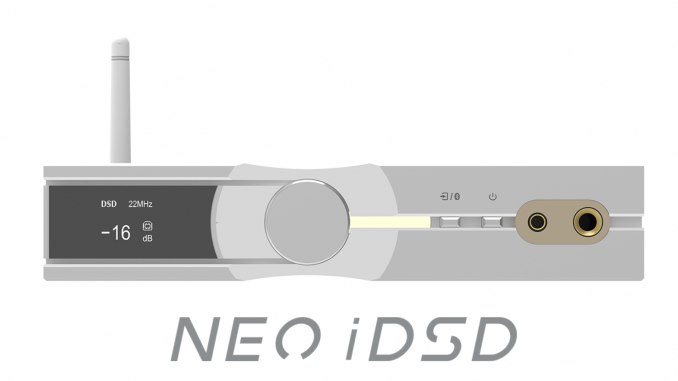
The iFI Neo i DSD Review. A “Do it all” for under $700.
By Steve Huff
A video look at the iFi Neo iDSD!
Sure I wanted to hear one of their DAC’s but the iDSD is much more than a DAC. It also houses a Headphone amplifier along with MQA decoding and bluetooth streaming. It’s also a full functioning pre-amp! All of this for a $699 retail price which is pretty inexpensive in the realm of HiFi.

In this review I will talk about this unit as it performs as a DAC in my reference system which resides in my new dedicated 12X18 listening room that I have been assembling for the last 6 months. The system as it sits today consists of a Pass Labs INT-250 integrated amplifier, Dynaudio Heritage Special Speakers, a Lumin UQ Mini Streamer and a Chord Qutest DAC. I have reviewed all of these items except for the Lumin (That is coming soon as I wanted to do a long term review as compared to my Bluesound Node 2i). I will touch on headphone, bluetooth and pre amp capabilities of the iDSD in a “Part 2” soon as for now I want to just focus on the DAC performance of this piece.
Guilty as Charged.
It’s true. I have not written much here for the last few weeks as I have been 100% content and happy with my audio system, and my camera system. I have also been insanely busy with life and other projects (A book being one of them). These days, I write on these pages for me, and for you. I do this as a passion rather than an income source. In fact, this website has become a bit dry on the content front this year as I have been busy listening to my audio system (and enjoying my camera) and for the first time in 20 years I find my audio system is not lacking in any real way. While I feel it could use a little bit more of this or that at times, and I am curious about many other products, it’s nothing that is mandatory or making me crazy wanting to change it up.
While I will be reviewing many more audio products here this year (and a handful of camera reviews) I am so happy with my system as a whole because it brings me musical enjoyment every day. Will I ever change it up again? I am sure I will as I am an audio guy and music is a passion of mine, but for now and for the foreseeable future, I am enjoying it more than ever before. These Heritage Special speakers have changed the game for me, love them.
The good news is I have been able to connect with a few audio manufactures lately and have sone exciting things on the way to test out and review for you guys. Things I can compare to this “reference” system I have created for myself. I will soon share my new Analog setup which will consist of a Dr. Feikert table and Pass Labs phono stage with a special cartridge that I have eyeballed for a few years. I will also compare my INT-250 to a set of Pass Labs Class A Amps and Preamp soon. I also tested a $160 turntable and cartridge setup for a truly beginner analog system. So stay tuned!
These days, wether it is a camera or audio product, when that new product lands in my lap and I test it for a while I will write about it if I feel it’s a good value or if it is extraordinary in its performance, or both. It can be affordable, a great bang for the buck, or something insanely expensive that takes things to a new level. If it brings a big smile to my face and adds to my enjoyment of music or life, you guys will know. If it provides a huge value to you guys, I will also write about it as I believe we need high quality affordable products in HiFi today to get more people into serous music listening!
Listening to a nice 2 channel system can bring tears to your eyes and truly touch your heart, and we do not always have to spend a fortune to get a taste of that. I love my quality high end audio products that deliver but also love the lower cost products that deliver. It’s why I have three audio systems in my home environment these days : )
In the case of the iDSD I was not sure what to expect but I did have some excitement as it is the first new DAC I would be trying in quite a while, and my main use of this piece during this review period would be for DAC duties. I was also happy for MQA decoding for streaming Tidal masters. Something my more expensive Chord Qutest lacks. While the Chord lacks this, I have enjoyed this little DAC for a couple of years. It’s meaty, full bodied, and never analytical or thin. It’s fluid, has texture and even some warmth. This is welcome with my Dynaudio Heritage Special speakers that can sound lean on the bass with some DAC’s or Amplifiers.
I also know how much a DAC can alter the sound in a revealing higher end system. I have had a few DAC’s that sounded glorious and some that sounded hard and digital. Some have sounded bloated and others have sounded dull. Some are closed in and some are expansive with some being artificial. Some are musical and toe tapping and some are not. In a nice system DAC’s do make a difference, and are just as important to me as an amp or speakers.
Two of my all time favorite DAC’s have been the Chord Qutest and the PS Audio Direct Stream.Two nice higher end DAC’s that are not cheap but sound beautiful.
So how would the much less expensive iDSD do when replacing what my ears have been used to for so long? I wondered if I would prefer it or find it similar or even dislike it? Would I replace my beloved Chord with it?

The iDSD Arrives.
One day I was out riding on my Scag Turf Tiger II mower (I have many acres of grass to mow these days and my smaller mower county handle it) when I saw the UPS guy pull up. He looked over at me, waved and then said “I have another package for you”! Woohoo, I knew what it was and I was excited to get it set up.
I hopped off my mower, grabbed the box and placed it in the house. After getting cleaned up I decided to set it up in my system replacing the Chord Qutest as a DAC and to let it run in for a few days. I had my Pass Labs INT-250 powering the Dynaudio’s but kept the volume low for 3 days of constant streaming.
This device has all the right inputs and outputs. Coax, USB, and optical with RCA and XLR outputs.
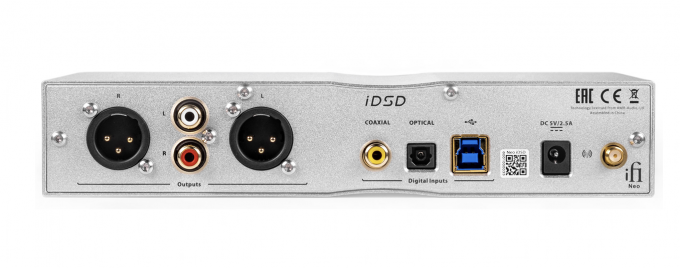
As a DAC, iFI has some big claims about the NEW iDSD:
“Hi-res audio support is state-of-the-art with True Native® playback. It handles PCM data to 32-bit/768kHz, DSD up to DSD512 and single and double speed DXD.
Thanks to the Burr-Brown DAC chip’s four-channel True Native design, PCM and DSD take separate pathways – this enables DSD, as well as PCM, to remain ‘bit-perfect’ in its native form right through to analogue conversion. This is not the case with all DAC devices from other brands – even if DSD compatibility is stated, many such DACs convert DSD signals to PCM.”
*BTW, the Chord Qutest converts DSD to PCM. A potential win for the iDSD.
and…
“The XMOS 16-Core chip processes the audio data received via the USB* digital input.
This new low-latency XMOS microcontroller has greatly enhanced processing power. Compared to the current generation of eight-core chips, this new 16-core IC delivers double the clock speed (2000MIPS) and four times the memory (512KB), as well as the latest SuperSpeed USB standard.
iFi’s in-house digital development team has programmed the XMOS firmware to optimise sound quality and ensure a perfect partnership with the Burr-Brown DAC.”
and…
“The Burr-Brown True Native® chipset means file formats remain unchanged or ‘bit-perfect’. This means you are listening to music as the artist intended in the format in which it was recorded.
At iFi we use Burr Brown extensively in our products having selected it for its natural-sounding ‘musicality’ and True Native architecture. Our experience with this IC means we know how to make the most of it.”
*I have found that in the past, Burr Brown DACS do have a sweet musicality to them.
and…I really like this one…
“Not only is the NEO iDSD a purist design – no DSP, no digital filter selection and no change in analogue playback – it is also all designed around a balanced circuit design named ‘PureWave‘. Read more below.
It uses audiophile-grade components and delivers sonic ‘purity’ thanks to the extraordinarily low levels of noise and distortion.”
*This is right up my alley as I personally prefer this purist approach. I am not a DSP fan nor a huge fan of filters in DAC’s.
Wow. This sounds like a killer DAC and going by what they are saying here, would seem too be VERY hard to beat for the cost, even if buying just to use as a DAC.

The Design
The design and the style of the iDSD is quite nice for a $699 product, in a snazzy modern kind of way. It’s silver, and has a nice digital display along with an input button and power button. There are two headphone inputs on the front and a nice big and shiny silver volume dial. It’s not heavy or substantial feeling so no, it doesn’t feel like a brick but I was more concerned with the sound. As far as looks, it passed the test with ease. On top of my Lumin U1 Mini it looked quite sharp.
I also like that this all in one device has balanced outputs. My Chord, which cost much more and is a DAC only device does not have balanced outs, so I was excited to try the iDSD with my RCA and XLR cables as my Pass Labs INT-250 can take balanced inputs and my Lumin U! mini has balanced outs. Perfect! I use Nordost Blue Heaven all throughout my system.
By the time I was ready to listen the system was fully warmed up and ready to rock and roll for critical listening. The iDSD was set to variable rather than fixed so I could go higher than the 2MV that comes from the fixed output. With variable you can set the output and this is essential when matching with your system. While Variable is meant to use with a power amp, in preamp mode, it works well going into the integrated as in fixed it seemed to have a much lower output. Direct does remove the volume control from the system so it would be best to use with an integrated but for me, it sounded better using variable and turning it up to its max. I heard no noise, hiss or anything offensive. Rather it was quiet as a mouse. Some systems can be well driven with 1MV and others may need 3. Having it on variable allowed me to set it to my preference for my system but for most who use this as a DAC the fixed setting would be best.
First Listens
I sat down and cued up tracks I know up and down, left and right and have heard hundreds of times as I test new gear. I know what these tracks sound like at their best and worst and all points in between. I especially am familiar with them with my Qutest DAC in the chain.
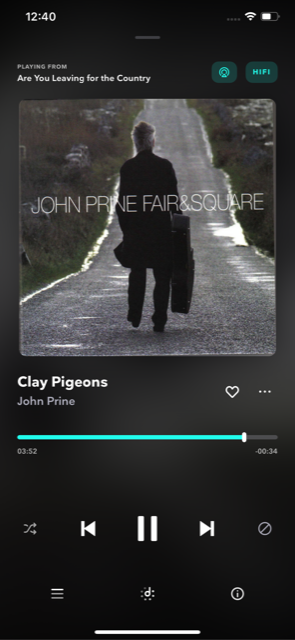
The first track was “Clay Pigeons” from John Prine and I was very pleasantly surprised at what I heard. In fact, and I mean this, I have never heard this track sound so good regardless of what system I had. There was a sweetness and clarity to the sound with a beautiful room filling expansive musical sound. Yes, musical is a thing. Not all DAC’s can pull this off. I was streaming from Tidal and this was not a “Master” so no MQA but it was such a touching and beautiful presentation. The soundstage was wall to wall and wide open with a true 3 dimensionality thing happening.
It is so sad that we lost this man recently, a victim to Covid 19. With the iDSD this track touched my heart and put me in a deep listening state for the entire song. I knew I would have to bring in the Chord Qutest and see what the difference was.
With the Chord…and the same track…
I lose some of the deep and wide soundstage which to be honest shocked me a bit. I lost some of the transparency and the sound did flatten a little. What?!?!? The chord had a “thicker” sound and had more meat on each instruments bone so to speak but it was not as immersive or sweet as the iDSD. I will say that the piano sounded better with the chord and the sound was more textured but the vocals sounded more real and present and in the room with the iDSD. The instrument separation was better with the iDSD as well.
For this track I preferred the iDSD but both were beautiful. I could love and live with either.
Back to the iDSD.
I then cued up an old favorite from Simon and Garfunkel. Listening to “Sparrow” from Tidal with the iDSD doing conversion duties.
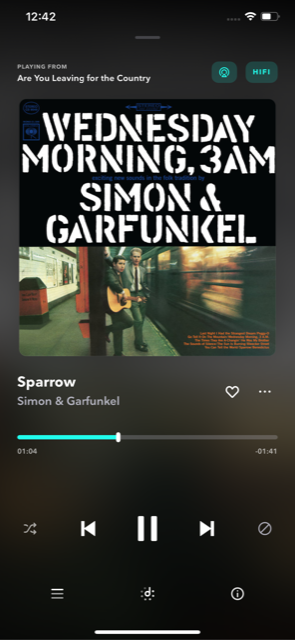
The vocals emerge with that sweet musicality again, and as the two voices emerge from each speaker the guitars are heard in their perfect places in space. It is so transparent and fluid and offers me the sound I remember from much more pricey dacs like the DirectStream from PS Audio, though not quite as refined as that one. (but ALMOST).
With the Qutest the sound was warmer leaning (with incisive filter on) and it had more impact and body, especially to the guitar. It sounded superb but lacked the width and expansion of the iDSD. This will come down to personal preference. The vocals of this duo in their prime is magic with either DAC but with the iDSD I heard that sweet flowing musicality. A tad less body but it didn’t matter as plenty of body was already there. The Chord just made it sound beefier and thicker with more texture. Two flavors that are more alike than different really but it shows how this $699 iDSD is a true powerhouse bang for your buck.

One more…
As I cued up “Take Me” from Karen Dalton (Tidal Streaming) I noticed quite a difference from the Chord DAC instantly.
Well, as I listened the differences I noticed from my Chord to the iDSD was that the iDSD brought a wider soundstage, more transparency and better imaging. Yep, I said “Better Imaging” which blew me away as the Chord is no slouch here. More of the same just like with the first two songs.
What did I lose from the Chord this time? I lost some body in the iDSD, some bass grunt, and some of that texture. The Chord, in my system, is the fuller “meatier” sounding DAC without question. It has more authority and kick but the iDSD has more delicacy and dare I say “magic”. When I use that word I mean it had a way of making instruments float in space better, and the instruments were more separated giving you a more impressive “audiophile” kind of presentation.

IN fact iFI calls the DAC in the iDSD as a “Super Dac”…
“The Burr-Brown DAC chipset still fuels the NEO‘s ‘digital engine’.
But we’ve souped it up with a new 16-core, XMOS microcontroller that processes the data via USB and S/PDIF digital inputs. Double the clock-speed. Four times the memory.
Add in jitter eradication including our GMT femto-precision clock, intelligent memory buffer and our GTO filter as standard, and you’ve got one heck of a super DAC.”
This is so much more than a DAC though as you can use this as a preamp as well straight into a power amp. Set it to Variable and use the volume dial to power your amplifiers. The more I discovered about the iDSD the more I was impressed with the price point. With so many items being priced into the stratosphere within high end Audio, the iDSD was proving it could hang with a DAC more than double its cost.
The iDSD, when used as a DAC in my reference system was interesting yet rather amazing for sure. It was more detailed than the Chord but wasn’t what I would call bright or thin, not at all. While it lost a teeny amount of midrange body, it brought more sparkle and air and almost like I could see into the music with more clarity. The bass was still very impressive when called upon, when in the track, but I did lose some of the fullness of the Chord in the midrange. This in turn, opened up the sound quite a bit more with some tracks which resulted in a better listening session for me.

Listening to Hobo’s Lullaby from Billy Briggs and Joe Henry the iDSD brought me into the studio where this was recorded. I felt as I was there with them in the room as they sang and played. It actually gave me chills at one point. THAT my friends is a tell tale sign for me that I am listening to something special. I have always said we should not equate price with performance as we can sometimes spend less and get that magic that we often hear in higher end pieces.
I swapped the Chord back in and the soundstage shrunk in width by a hair, and the sound became a bit more direct and the midrange “bloom” and body returned but it also made the sound a little bit darker, which you may prefer or not. This would come down to the sound of your system now. Is it warm or does it lean to the bright side? Is it thick or lean? Does it need a dose of “air” or a dose of “density”?
To be honest, after a few tracks I was not sure which I preferred! They were bringing different presentations for sure and with the iDSD it sounded more like what an “audiophile DAC” would sound like. The enhanced 3 dimensionality, the big soundscape presentation and top end details that you may have missed with lesser dacs along with that oh so sweet musicality, and yes, it does sound SWEET!
The fact that this piece also has a headphone amp, high res bluetooth streaming, can be used as a preamp and has balanced outputs is pretty incredible when you consider the $699 (Update: NOW $799) price tag. I paid $1800 for my Qutest DAC and it offers nothing more than being a single ended DAC without MQA capability.

MQA
I decided to que up a few tracks on Tidal that take advantage of MQA and I admit, the differences were not night and day but something was going on. There was a difference with MQA streaming and for the better. The MQA tracks sounded a bit warmer and natural to me and lived up to the “more analogue sounding promise” of MQA in this configuration. It was also even more musical. With my Lumin U1 mini streaming to the iDSD I was able to take full advantage of the MQA tracks and they sounded absolutely fantastic. So good in fact that if Tidal was my only source of music, and ALL tracks were with MQA I would keep the iDSD in my reference system, without hesitation (I may anyway as it is). It can hang with the Qutest all day long (and even surpass it) no matter how you slice it.
Listening to Terry Caller’s “Oh Dear, What Can The Matter Be” as a Tidal Master was a beautiful experience. The vocals were dead center as they should be, with a sweet depth and clarity to them. I felt as if I was getting a personal intimate performance in my listing space. The guitars sounded like guitars and there was a tangible sweetness to the entire presentation. With the Qutest in place it became a little darker and a little more closed in. Very interesting indeed!
Going to something with more backbone I loaded up the latest from Weezer “Van Weezer”. The first track “Hero” blasted through my Heritage Specials turning then into what sounded like full range monsters. Deep big drums sounds, a massive beat with backbone and balls. It retained that expansive sound but also had some grunt and drive. With the Chord it had that drive and grunt as well but lost some sparkle and excitement.
The iDSD Surprised Me.
My first evaluation of this product just using it as a DAC was a very positive one, and I feel it is worth its asking price for the DAC alone. It brought more of that magic to my space that immersed me in the music just that much more. It touched my heart on more than one occasion and had me listening for hours on end. I will do another write up down the road with the headphone capabilities, pre amp and even the bluetooth capabilities of this piece. The fact that it has all of this for $699 (now $799) shows that today in 2021 we can get true high end for less, if we are willing to accept the fact that an affordable piece can deliver high end sound (it does).

I have to say that there was one track that finally sealed the deal for me. When listening to one of my favorite Simon and Garfunkel tracks with the iDSD I actually had my mind blown. “The Only Living Boy in New York” sounded so alive, so amazing, so real, so in my room and so beautiful I knew this iDSD, as a DAC, was a slam dunk winner. It took away the slight closed in sound of the Chord (that I never noticed until now) and blew it wide open.
If just this DAC alone was placed in a fancy enclosure with an exotic name and priced at $3,000 many would be raving about its performance. This is truth.
While some expensive high end audio pieces are truly worth their weight in gold, some less expensive pieces perform very close to some of these high end pieces. The iFI Neo iDSD is one of these rarities and gets a huge HIGHLY recommended from me.
BTW, I did try the iDSD with some Nordost Blue Heaven XLR cables and not only did it sound a but better still, but on the fixed volume position it put out plenty of drive and sounded amazing. I will 100% use this with XLR cables coming from my Lumin U1 Mini.
You can buy it on Amazon via Prime HERE.
You can read more info about the Neo iDSD on iFI’s website HERE
You can follow iFI on social media:
Instagram:
Facebook:
Twitter:


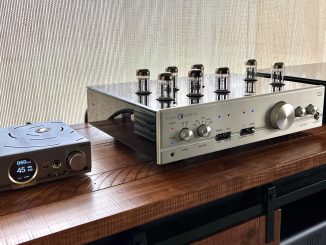
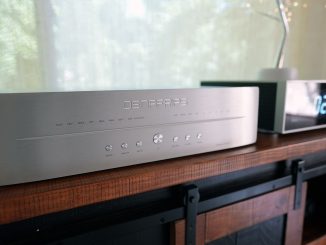

I see this product is now listed at $799 on Amazon. Probably due to your glowing review! LOL
Thank you for this interesting comparison Steve 🙂
Did you use the Chord with its stock power supply? I’m asking because upgrading the power supply improves the Chord quite a bit in terms of holographicness and delicacy.
I tried the upgraded power supply and truly found zero difference. It also invalidates the warranty. ; )
I enjoyed reading this review of the EFI Neo i DSD. I think it is a great product for people looking for something that can do everything, and at a reasonable price! It sounds like you have tried out all sorts of different cables with it too, which is interesting to know.
Hi Steve
Been following you for a while reading regularly your posts on camera equipment reviews and Hi Fi. Read your iFI Neo review and an opportunity came along to purchase this at around $400 used. Received it yesterday and tried it straight away.
My system is very high end and extremely transparent. I have only tried PCM mode so far. I am blown away by this DAC. You have described it 100% correctly. The transparency of this little device and its ability to bring out micro details is really mind boggling.
I’m really looking forward to the review of the Lumin U1 Mini! I’m debating upgrading from the Node 2i.
Hello Steve, I wrote to you about comparison with dac in bs node 2i, please confirm you received my message and let me know at your earliest convenience, thanks!
Steve
You claimed above you are replacing the Chord Qutest, what about the Chord M Scalar that you reviewed and used earlier? Are you still want to connect the M Scalar to the IFI Neo?
Hello Steve,
thanks for this great review, and your many others all of which I have read and viewed on You Tube.
My system is composed by Willsenton R8, BS Node 2i and Vienna Mozart Grand SE and I enjoy it very much.
I am passionate about gear but trying to stay away from the rabbit hole. I am curious to hear how much better is this dac compared to the one in the Node 2i. It is probably better but, is it a big and easy to see the difference or you have to a/b it carefully to notice it? I prefer to focus on the music and not spend too much time analyzing the sound…
Greetings from Rapallo, Italy
Almost any good external DAC will gibe you a better sound over the built in DAC of the Node 2i. Yes, this will make a difference in transparency, soundstage, dynamics, etc. Just take the digital out of the Node 2i and go into the iFI ; )
Steve
How do you connect your streamer to this unit?
Digital out to the inputs. This has a number of different inputs. If you run a Node, take the COAX out and feed it into the COAX in, and then choose that input on the front panel of the NEO DSD. Thank you.
Great Review as always. So I see you finally picked up an analog rig…care to share what turntable that is ? Did you pick up a pass phono stage ?
It was supposed to be in over a week ago but was delayed…so still waiting ; ) I will reveal soon, and thank you!
Very interesting. Naim have just released their new Atom Headphone Edition, similar concept plus streaming. The price differential is considerable. This company produces products with an amazing price to performance ratio. They are still headquartered in England but have a very global outlook, with online sales the biggest driver. All my nephews/ nieces and their friends use this stuff, the portable gear especially. They produce a small bookshelf speaker called the LS 3.5 with a bamboo cabinet. Beautiful tone, very compelling when I heard it. A more capable version with a bigger woofer would be irresistible.
The Naim Atom is FANTASTIC. I have not used the new one as I am not a headphone guy but the original Atom is nice. With that said, I always prefer an external DAC as it’s an easy way to get different sounds and keeps me from going down the rabbit hole too much. I have 3 DAC’s here, and can change up the sound from time to time if I like. But the Atom and Nova are fantastic pieces that punch well above their weight.
Agree completely. A completely stand alone analogue amp, with separate DAC, CD transport, streamer is the way I will go when I next upgrade. DAC performance is evolving all the time so it seems silly to lock yourself in…
I am stuck with my small, difficult room, so what I need is more quality. My HiFi dealer popped in…the sound he said was good, and with simple, non-complex recordings verging on very good. He was surprised at the quality of the sound I had been able to realise from my equipment in the setting. He was shocked at the difference my bamboo chopping board made (vibration dampener) when I moved it in and out of the system! Trial and error is essential, in my own room. Sadly, he confirmed the Wharfedale Elysian 2 would not be a good fit. Better quality small bookshelf is the first step in the upgrade…
NAIM sound is very particular i.e. dynamic, punchy and focusses mainly on the high and low frequencies leaning more towards the bass hence its punchiness. It’s not a bad sound just different. I have a NAIM CDX2 cd player which is great. However my current experience with the NAIM SuperNait 3 Integrated is a mixed bag. Fantastic build and excellent value for money. Although it has lots of punch and clarity it does so with a lack of transparency. It is a very revealing amplifier but loses out in terms of full range resolution specially in the mid range. I would say the frequency range it displays is not flatline maybe enjoyable to some but will not be to everyone’s taste. Sometimes I think the sound is too exciting and can lead to ‘listening fatigue’. This is the NAIM sound in IMHO. The Atom and Nova have similar sound signatures.
Fascinating. I have recently heard a Naim SN3 in comparison with 5 other amplifiers, and to me it sounded the most polite, almost reticent. I initially was thinking it was excessively laid back, but it won me over. I found it the least fatiguing in the end.
Fascinating. My experience of the Naim SN3 is approaching the opposite. A very polite sound, refined. Im comparison to all the other amps I trialled it against it initially sounded a touch bland. The treble just a touch rolled off, which suits me. I wanted more excitement at first! It grew on me. I found it the least fatiguing in the end. The bass was hefty but only when the recording asked for it. Comparing the SN3 to the Nova, which I know well, is interesting. The SN3 has better sound staging and instrument separation, manages complex music more deftly and really ups the quality of the bass.
I am actually really shocked by the SN3’s sound. I love it’s build, price and everything else about it. However I keep going back to my old amp which is more transparent and has all the different nuances which the SN3 cannot portray. To me the SN3 is like an energetic stallion with plenty of bass and rolled off high end and less mid range. It’s not a bad sound just different and not to 100% to my liking.